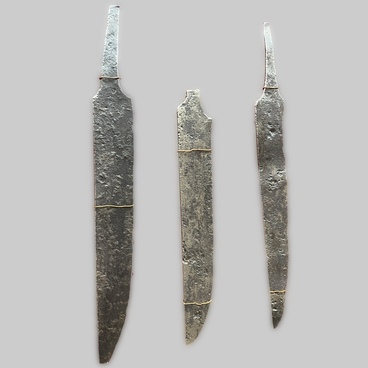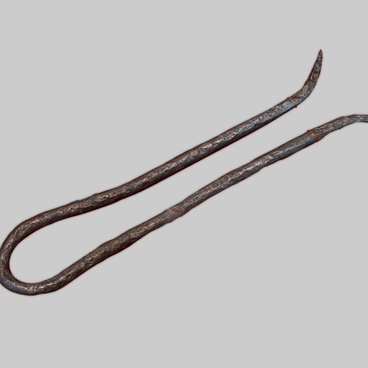The file from the museum permanent exhibition was found during archaeological excavations in Kuznetsk osrtrOg. (small wooden fort). The body of the file gets narrower towards the end. It was forged from steel and thermo-hardened in cold water, and a special herring-bone notch was made on the file with a special chisel.
The history of the file started with processing stones, shells and other hard but fragile materials. Initially, flat stones with water and sand were used as files. But the stone roughness was insufficient for processing wood, that is why the craftsmen considered replacing the tool.
Metal files appeared as soon as people learned to process metals. Blacksmiths encountered certain difficulties while manufacturing files as the hardness of the file surface and that of the chisel used to manufacture the file were practically the same. They had to heat the file blank before notching it in order to reduce its hardness. But even such heating could hardly improve the chisel durability.
After the craftsmen mastered the methods of iron processing, the hardness of cutting tools improved within quite a short time – it became possible to harden the razor edge. After that its durability increased several-fold.
Gradually, various file manufacturing techniques were developed in medieval Europe. Theophole Gautier’s essay а “Schedula diversarum artium” dated X–XI cent. and dealing with various arts and crafts, described the manufacture of a file. Heavy and mid-weight files were made of homogeneous steel. They were four-sided, three-sided and round-shaped. Besides, there existed heavier files. Inside those there was soft iron covered with steel from the outside. After manufacturing them, the craftsman smoothed them using a round grinder and then notched it using a hammer pointed on both sides.
Other files were notched with a chisel. It was meant for fine processing of an item upon its preliminary rough sawing. At the final stage of manufacture the file was hardened.
Another chapter of the essay tells about the manufacture of small files from iron, followed by cementing of the notching dents and thermohardening. The first known automatic unit for notching the files was described in a manuscript by Leonardo da. Vinci. The carriage with a blank fixed in it is moved by a screw feed from the main shaft drive. On the same shaft a wheel with “fingers” is installed raising the hammer head with the chisel. The main shaft was rotated manually.
A file is an indispensable tool for fitters. Judging by its appearance, it was used for making round or oval holes and daps. In excavations, rasp files are also encountered, i.e. the files for processing soft materials – wood, bone, soft metals. Large spaced notches allow processing soft materials without clogging with chip scrap.
The history of the file started with processing stones, shells and other hard but fragile materials. Initially, flat stones with water and sand were used as files. But the stone roughness was insufficient for processing wood, that is why the craftsmen considered replacing the tool.
Metal files appeared as soon as people learned to process metals. Blacksmiths encountered certain difficulties while manufacturing files as the hardness of the file surface and that of the chisel used to manufacture the file were practically the same. They had to heat the file blank before notching it in order to reduce its hardness. But even such heating could hardly improve the chisel durability.
After the craftsmen mastered the methods of iron processing, the hardness of cutting tools improved within quite a short time – it became possible to harden the razor edge. After that its durability increased several-fold.
Gradually, various file manufacturing techniques were developed in medieval Europe. Theophole Gautier’s essay а “Schedula diversarum artium” dated X–XI cent. and dealing with various arts and crafts, described the manufacture of a file. Heavy and mid-weight files were made of homogeneous steel. They were four-sided, three-sided and round-shaped. Besides, there existed heavier files. Inside those there was soft iron covered with steel from the outside. After manufacturing them, the craftsman smoothed them using a round grinder and then notched it using a hammer pointed on both sides.
Other files were notched with a chisel. It was meant for fine processing of an item upon its preliminary rough sawing. At the final stage of manufacture the file was hardened.
Another chapter of the essay tells about the manufacture of small files from iron, followed by cementing of the notching dents and thermohardening. The first known automatic unit for notching the files was described in a manuscript by Leonardo da. Vinci. The carriage with a blank fixed in it is moved by a screw feed from the main shaft drive. On the same shaft a wheel with “fingers” is installed raising the hammer head with the chisel. The main shaft was rotated manually.
A file is an indispensable tool for fitters. Judging by its appearance, it was used for making round or oval holes and daps. In excavations, rasp files are also encountered, i.e. the files for processing soft materials – wood, bone, soft metals. Large spaced notches allow processing soft materials without clogging with chip scrap.



